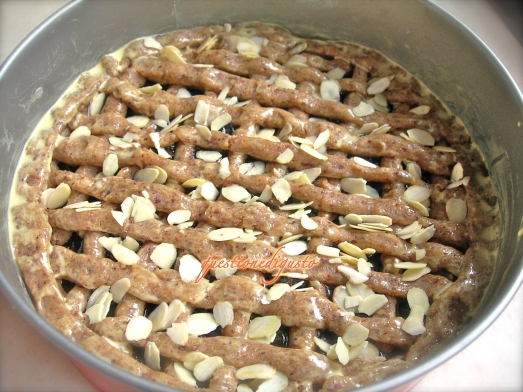La mia relazione intima con il forno inizia ad avere i giorni contati. Il caldo che, nell’ultima settimana, mi ha permesso di indossare le prime magliette a maniche corte, è lo stesso che mi imporrà una pausa dalle temperature eccessive in cucina, ma tanto per cogliere al volo le ultime occasioni, un compleanno mi ha fornito la scusa di testare un dolce che mi ronzava in testa dai tempi dei tempi: la Linzer Torte.
Quando ho optato per questo regalo, è stato inevitabile, curiosare sul web per risalire alle origini e scoprire che la Linzer Torte è forse una delle torte-crostata, che rendono famosa la pasticceria austriaca e in particolare la città di Linz, ma non immaginavo certo si trattasse della ricetta dolce più antica conosciuta al mondo (solitamente apro il frigo, controllo quali sono gli ingredienti che vanno assolutamente consumati e da lì inizio a decidere su cosa monopolizzare la mia attenzione, più semplice indubbiamente); si parla addirittura, di metà Seicento, e di un’origine non proprio austriaca, bensì veronese (tanto lo sapevo, che quando si tratta di dolci, mi dispiace, ma la nostra pasticceria è di un altro livello).
Per il primo test mi sono affidata alla ricetta originale che ho trovato qui, optando per alcune semplici modifiche (anziché grattugiare le nocciole, ho usato direttamente della farina di nocciole, ho evitato la vaniglia, ma non ho lesinato con le altre spezie ed infine ho seguito il suggerimento di un’amica, che mi ha consigliato di utilizzare un foglio d’ostia prima di versare la marmellata così da ottenere una cottura perfetta della frolla).
Ricetta Originale per la Linzer Torte (fonte Linz saluta )
150 g burro
250 g farina 00 (io ho utilizzato della semplice 0)
150 g zucchero a velo
100 g nocciole arrostite (o farina di nocciole)
1 uovo
spezie (vaniglia, scorza di limone, 1 cucchiaino di cannella, 1/2 cucchiaino di polvere di chiodi garofano)
10 g lievito in polvere
300 g marmellata di ribes (io ho usato quella di amarene, e per non far bagnare la frolla, anche un foglio d’ostia)
Unite la farina al lievito e poi con quella di nocciole, poi lo zucchero e le spezie. Dopo aver mescolato bene, cominciate ad aggiungere il burro a cubetti e successivamente la scorza di limone. In ultimo aggiungete l’uovo, ed impastate il tutto fino ad ottenere un composto liscio ed omogeneo, che lascerete riposare in frigo per almeno un’ora.
Foderate con della carta forno una tortiera (possibilmente a cerniera, così da faticare di meno e non rompere la frolla), su cui adagerete tre quarti della pasta, che avrete lavorato fino a raggiungere circa 1,5 cm di spessore e coprite completamente il fondo della torta con il foglio di ostia, che avrete ritagliato adattandolo al vostro cerchio di base (Se trovate le cialde piccole va bene lo stesso). A questo punto, ho distribuito l’ultimo barattolo di marmellata di amarene, fatta in casa lo scorso anno, poi con il restante impasto, ho fatto dei rotolini sottili per comporre la grata della crostata, lasciandone un ultimo più largo per i bordi esterni. Spennellate la superficie con del tuorlo ed in ultimo disponete, le lamelle di mandorla nei fori in cui spunta la marmellata.
Mettete a forno per 40–45 minuti a circa 190 gradi. E se volete, anche se la ricetta non lo prevede, una volta sfornata potete spolverare la vostra torta con dello zucchero a velo.
Assaggiate e ditemi… è più italiana o austriaca?
My intimate relationship with the oven started its countdown. The heat in the last week, which allowed me to wear the first short-sleeved shirts, it is the same that will impose me a break from excessive temperatures in the kitchen, but just to seize upon the latest bargains, the excuse came up due to a birthday, so I was able to test a cake that was buzzing in my head since centuries: the Linzer Torte.
When I opted for this gift, it was inevitable, to browse a bit the web to go and find the roots of the Linzer Torte: perhaps one of the pies-tarts, which makes famous the Austrian pastries and especially the city of Linz, but I never imagined that this was the oldest dessert recipe known in the world (how I make a decision about the cake to bake ?? Usually I open the fridge, check what are the ingredients that need absolutely to be consumed and from there, I begin to decide on what I can bake… undoubtedly the simplest way!), something like mid-seventeenth century, and documents tell that arrives not from Linz, but Verona (when it comes to cakes and pastries, I’m sorry, but our tradition is a bit more winning).
For the first test, I have relied on the original recipe that I found here, opting for some simple changes (instead of grated hazelnuts, I used directly the hazelnut flour, I avoided the vanilla, but I did not skimp with the other spices and following the suggestion of a friend, I useD a sheet of wafer before pouring the jam so as to obtain the perfect cooking of the pastry).
Original Recipe for Linzer Torte (source Linz Tourist Office)
150 g butter
250 g 00 flour (I used the simple 0)
150 g icing sugar
100 g roasted hazelnuts (or hazelnut flour)
1 egg
spices (vanilla, lemon zest, 1 teaspoon cinnamon, 1/2 teaspoon of ground cloves)
10 g baking powder
300 g homemade cherry jam (I used the black cherry, and so as not to wet the pastry, even a sheet of wafer)
Combine the flour with the baking powder with the nuts, then the sugar and spices. After mixing well, start adding the butter into cubes and then the lemon zest. Finally add the egg, and knead together until the mixture is smooth and homogeneous, let it rest in the fridge for at least an hour.
Lined with paper baking a cake pan (preferably hinged, so as to save effort and not break the crust), where you will put the three-quarters of the dough, which you have worked up to about 1.5 cm in thickness and completely cover the bottom cake with sheet of wafer, which you cut to best fits at your basic circle (If you find the small pods that’s okay either, less work). At this point, I distributed the last jar of cherry jam, homemade last year, then with the remaining dough, I made thin rolls to create the grate of the tart, leaving a final wider for the outside edges. Brush the surface with egg yolk and finally you put the sliced almonds into the holes where the jam comes out.
Put in the oven for 40-45 minutes at about 190 degrees. And if you want, even if the recipe does not mention it, once baked your cake you can dust with icing sugar.
Try and tell me … is more Italian or Austrian?
















